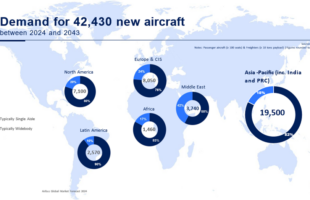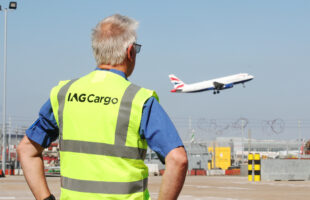“That should be sustainable, consistent with the need to redress the global imbalances in savings and investment that accompanied the preceding growth phase. Intra-Asian trade is also expected to recover more quickly than exports to Europe and North America.â€Â
Herdman is not alone. A short time ago at the Air Cargo Forum (ACF) in Kuala Lumpur, where Asia was the focus of discussions on hope for the cargo sector, Didier Lenormand, Airbus freighter aircraft head of marketing pointed out that “worldwide growth (of freighters)†would be impacted by the economic crisis, but that Asia was in a better position to handle it. His reasons: the Asian market continued to be strong because of intra-Asia traffic – especially between the Indian sub-continent and Southeast Asia.
Lenormand went on to say that the “underlying factor would be its (Asia’s)large population. Asia is full of highly populated countries with a rising numberof middle class people that have muchpurchasing power…So, you (Asia) are notonly the producers of consumer goods)but you are also the consumers.â€Â
Indeed, figures from Airbus and Boeing’s Global Market Forecast point out that while global air freight traffic could record an average annual growth of 5.8 per cent from 2007 to 2026, Asia would lead with intra-Asia trade likely to increase at 8.6 per cent per year until 2026.

Asia’s ‘green shoots’
While recovery might take some more time, the present situation doesshow ‘green shoots’ of recovery despite the fact that Asian and SE Asian airlineswere witnessing drops in passengers andcargo tonnage. AAPA’s Herdman agreedthat all airlines were certainly facingsevere challenges as a result of sharpfalls in both passenger and cargo traffic,compounded by declining yields in anextremely competitive market and theAsia Pacific airlines were no exception.
“Airlines have been trimming capacity by reducing frequencies, whilst generally trying to maintain their global networks. Measures to control staff costs have included reductions in bonuses and other forms of performance-related pay, as well as unpaid leave schemes,†he said.
Even so, the AAPA chief told Payload Asia that “air cargo volumes appear to have stabilised, and we’re hopeful that we’ll see a modest pickup in demand in the second half of the year, albeit at levels well below the same period last yearâ€Â. Herdman also noted that while AAPA international air cargo traffic in May was down 18.6 per cent, it was a slight improvement on the average decline of 23.2 per cent seen during the first five months compared to the same period last year. And its most recent figures showed air freight traffic grew again, up slightly from May to June with a 17.4 per cent decline in traffic compared to June a year ago. Load factors also climbed, hitting 66.8 per cent.
The International Air Transport Association (IATA), in its monthly traffic analysis for May 2009, emphasised the presence of “green shoots†of growth. It stated: “Air freight tonne kilometers flown were down 17.4 per cent in May, compared to a decline of 21.7 per cent in April. Freight volumes had been moving sideways from month to month since hitting their low point in December. May marked the first month of noticeable improvement, as manufacturers increased shipments, beginning to add to inventories in anticipation of economic recovery.â€Â
IATA however, hastened to add that despite the apparent stabilisation of travel and freight volumes “the same is not true for revenues. Passenger and freight yields are falling at an accelerating pace as excess capacity emerges, intensifying competition. As capacity cuts continue to lag behind the slump in demand, passenger load factors fell by 3.3 percentage points in the 12 months to May, while freight load factors fell a further 3.6 percentage pointsâ€Â.
SE Asian optimism
Barring that jarring note, the underlying optimism cannot be missed by the cargo sector. There are, however, a number of people who expect more out of Asia. TNT, for example, is a strong advocate of the Southeast Asian market. Recently, the logistics major hiked its express service capacity in Thailand to cater to increasing demands. A new hub that is three times the capacity of its hub in Klong Toey (it handled 40 tonnes or 4,500 consignments per day) was opened in Lam Luk Ka district, Pathum Thani. TNT believes that the freight market in Asia was expected to have 13 per cent compound annual growth over the next five years.
And similarly DHL also recently announced a new joint venture in Vietnam. The company signed an agreement with its local Vietnam partners including Oriental Logistics, to form a new entity, DHL Global Forwarding (Vietnam) Corporation. As part of this investment, by end 2009,DHL will also launch the DHL Fashion and Apparel Centre for Excellence in Vietnam, its first in Southeast Asia.
DHL estimates the Fashion and Apparel Logistics industry to be worth US$3.9 billion per annum in South Asia and Southeast Asia. Vietnam, Indonesia and Cambodia alone are estimated to account for well over $2.5 billion in this fast-growing industry.
The overall Asian cargo market is around $30 billion. According to the 2008 Global Air Freight Forecast by OAG, the intra-Asian airfreight market would grow at an average annual rate of 7.5 per cent between 2008 and 2017, more than the projected growth of 6.1 per cent for the international aircargo market.
Asia, as per IATA chief Giovanni Bisignani’s reckoning, is among the three fastest-growing express markets in the world. He told a cargo symposium in Mexico City way back in March 2007 that by 2010, total intra-Asia freight would reach 8.3 million tonnes, 26 per cent of total international freight and that China was expected to account for 30 per cent of that growth.

Better times ahead
And even better times lie ahead because China along with the Association of Southeast Asian Nations comprising Brunei, Myanmar, Cambodia, Indonesia, Laos, Malaysia, the Philippines, Singapore, Thailand and Vietnam, are expected to create a free-trade area by 2010 that will contain 1.8 billion consumers and produce $1.2 trillion in trade volume.
In fact, the one sure sign that the situation is improving by the day comes from the express industry. TNT’s expansion is only another case in point. FedEx and UPS are the other two players that are betting big on Asia. Both have set up hubs in southern China’s Guangdong province, which according to pundits, would be the centre of action for the intra-Asia express market.
If there is any other indicator that intra- Asia trade has been growing, figures released by the China-ASEAN Business Council only go to show that despite the gloomy international scenario, the markets had been doing well. Trade between ASEAN and China reached $54.4 billion during the first quarter of 2008, up 26.2 per cent from the same quarter in 2007. In fact, the 2007 figures showed that trade had reached $202.6 billion in 2007, up 25.9 per cent from 2006.
The presence of multinational corporations setting up business in Southeast Asian nations have also seen a rise in business activity. This has resulted in more business-to-business activity with a number of Asian countries transporting unfinished products for completion somewhere else within the region.
But one question that now becomes pertinent given the global economic malaise is whether the markets in Asia would be able to take care of all the manufacturing within the region now that the big money that was coming from exports to the US and Europe has dwindled? Herdman believes that Asia will be able to take care of itself adequately.
“The slump in exports of manufactured goods reflected aggressive destocking throughout the supply chain, adjusting to the sharp economic slowdown during the first half of the year,†he said.
“Air cargo was particularly hard hit, even more so than ocean shipments. Nevertheless, we would expect to see a pickup in demand for air cargo before too long, given the declines in retail sales in both Europe and North America have been much less severe than the fall in shipments from Asia. An uptick in recent surveys of purchasing managers’ confidence levels regarding future order trends is another positive sign,†he pointed out.
The current challenges notwithstanding, the Asia Pacific aviation sector hopes that a recovery in the global economy should begin to take shape in 2009-2010. As Herdman put it: “Asia Pacific airlines are well positioned to take advantage of further industry growth opportunities inthe years ahead.â€Â







